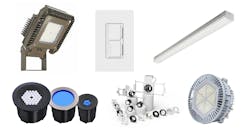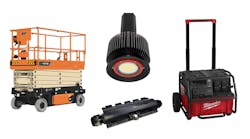Responsible for preventive maintenance for East Carolina University's 115 buildings in Greenville, N.C., PM engineer Anthony Patrick says his employees are required to perform 30-sec (monthly) and 90-min. (yearly) tests on all emergency exit lights in buildings not connected to back-up power generators per NFPA 101, Chap. 7, Sec. 9.3. In the past, this task required pressing a manual switch located on each exit sign.
Climbing a ladder to push a button may not seem that time consuming — until you multiply this act by 50 to 100 emergency exit signs per building. But by using the new CheckMate ET1, a remote control emergency exit light tester designed by Collierville, Tenn.-based life-safety products manufacturer The Bodine Co., Patrick estimates he saves 70% to 75% in man-hours on the annual 90-min. testing alone.
“Our life-safety people love it,” Patrick says. “When they get on a long hallway, they can walk down the hallway and activate all of them without having to carry a ladder.”
Not having to use a ladder also prevents injuries caused by slipping off of the structure or being bumped by someone passing by, especially when testing exit signs in the middle of heavy-traffic hallways and corridors.
Designed by Bodine's R&D manager David Crenshaw in the late '90s for emergency lighting ballasts, the remote control test (RCT) technology was recently applied to emergency exit signs after Patrick expressed interest in such a product to a Bodine sales representative. Crenshaw had received a patent in March 2004 to use RCT technology on emergency exit signs, but says that the customer interest later that year was the catalyst for actually developing the product for commercial use. Released to the public on December 1, 2005, the CheckMate ET1 can activate monthly or yearly testing using a remote control (model WHRCT, sold separately) within 30 feet of the device.
“This test involves simulation of a power outage to the emergency exit sign,” says Crenshaw. “The exit sign must then operate from its own internal battery during the test, which is designed to test the readiness of the battery and the lamps in case of an emergency.”
The RCT feature works by replacing the manual testing switch with a relay that is controlled by a circuit mounted inside or on the unit, explains Crenshaw. The control circuitry incorporates an infrared detector and a microcontroller that is activated by the infrared hand-held remote control transmitter. A single remote can be used to test any CheckMate ET1. In order to make this technology reliable, Crenshaw had to come up with his own infrared code for transmitting and receiving to avoid noise interference. “Infrared energy is abundant anywhere you have fluorescent lighting, and it's in the form of noise,” Crenshaw says. “The [infrared] code was designed to penetrate that noise so that the receiver could discriminate against all the noise and pick out this transmitter signal easily.”
Although Crenshaw concedes that CheckMate is not the only way to test emergency exit lights without using a ladder, he doesn't recommend the alternative: An individual can throw the breaker for a branch circuit and then go back and look at the entire branch to see if all exit signs are lit. The problem with this method, he maintains, is that it leaves an entire area without power. “So during the day — or when there's activity going on — that's not very feasible to do,” Crenshaw says. “Code regulations do not recognize or advocate this method of testing.”
Alternatively, Crenshaw hopes that CheckMate ET1's ease of use will encourage more people to follow the NFPA code. “By having the remote control, we remove that inconvenience factor,” Crenshaw says. “By making it convenient, hopefully it will promote the idea that this needs to be tested.”
Priced around $25, CheckMate ET1 is not only simple to use — it's also easy to install and works with most existing fixtures, according to Patrick.
“It's a 3-wire hook up. You have to drill a ½-inch hole in the outside of the device — then it's just very simple wiring,” he says. “It takes our people about 5 minutes to install this — that includes setting the ladder up and getting to the exit sign.”
For more information, visit www.bodine.com.



